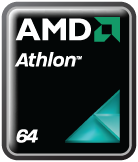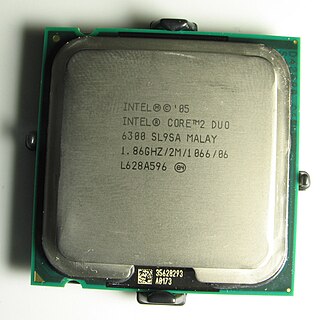
Athlon is the brand name applied to a series of x86-compatible microprocessors designed and manufactured by Advanced Micro Devices (AMD). The original Athlon was the first seventh-generation x86 processor and was the first desktop processor to reach speeds of one gigahertz (GHz). It made its debut as AMD's high-end processor brand on June 23, 1999. Over the years AMD has used the Athlon name with the 64-bit Athlon 64 architecture, the Athlon II, and Accelerated Processing Unit (APU) chips targeting the Socket AM1 desktop SoC architecture, and Socket AM4 Zen microarchitecture. The modern Zen-based Athlon with a Radeon Graphics processor was introduced in 2019 as AMD's highest-performance entry-level processor.
Celeron is a brand name given by Intel to a number of different low-end IA-32 and x86-64 computer microprocessor models targeted at low-cost personal computers.
Pentium 4 is a brand by Intel for an entire series of single-core CPUs for desktops, laptops and entry-level servers. The processors were shipped from November 20, 2000, until August 8, 2008. The production of Netburst processors was active from 2000 until May 21, 2010.

The Pentium II brand refers to Intel's sixth-generation microarchitecture ("P6") and x86-compatible microprocessors introduced on May 7, 1997. Containing 7.5 million transistors, the Pentium II featured an improved version of the first P6-generation core of the Pentium Pro, which contained 5.5 million transistors. However, its L2 cache subsystem was a downgrade when compared to the Pentium Pros.

The Pentium III brand refers to Intel's 32-bit x86 desktop and mobile microprocessors based on the sixth-generation P6 microarchitecture introduced on February 26, 1999. The brand's initial processors were very similar to the earlier Pentium II-branded microprocessors. The most notable differences were the addition of the SSE instruction set, and the introduction of a controversial serial number embedded in the chip during the manufacturing process.
The Pentium Pro is a sixth-generation x86 microprocessor developed and manufactured by Intel and introduced on November 1, 1995. It introduced the P6 microarchitecture and was originally intended to replace the original Pentium in a full range of applications. While the Pentium and Pentium MMX had 3.1 and 4.5 million transistors, respectively, the Pentium Pro contained 5.5 million transistors. Later, it was reduced to a more narrow role as a server and high-end desktop processor and was used in supercomputers like ASCI Red, the first computer to reach the teraFLOPS performance mark. The Pentium Pro was capable of both dual- and quad-processor configurations. It only came in one form factor, the relatively large rectangular Socket 8. The Pentium Pro was succeeded by the Pentium II Xeon in 1998.

The Athlon 64 is an eighth-generation, AMD64-architecture microprocessor produced by AMD, released on September 23, 2003. It is the third processor to bear the name Athlon, and the immediate successor to the Athlon XP. The second processor to implement the AMD64 architecture and the first 64-bit processor targeted at the average consumer, it was AMD's primary consumer microprocessor, and primarily competed with Intel's Pentium 4, especially the "Prescott" and "Cedar Mill" core revisions. It is AMD's first K8, eighth-generation processor core for desktop and mobile computers. Despite being natively 64-bit, the AMD64 architecture is backward-compatible with 32-bit x86 instructions. Athlon 64s have been produced for Socket 754, Socket 939, Socket 940 and Socket AM2. The line was succeeded by the dual-core Athlon 64 X2 and Athlon X2 lines.
The Pentium M is a family of mobile 32-bit single-core x86 microprocessors introduced in March 2003 and forming a part of the Intel Carmel notebook platform under the then new Centrino brand. The Pentium M processors had a maximum thermal design power (TDP) of 5–27 W depending on the model, and were intended for use in laptops. They evolved from the core of the last Pentium III–branded CPU by adding the front-side bus (FSB) interface of Pentium 4, an improved instruction decoding and issuing front end, improved branch prediction, SSE2 support, and a much larger cache. The first Pentium M–branded CPU, code-named Banias, was followed by Dothan. The Pentium M-branded processors were succeeded by the Core-branded dual-core mobile Yonah CPU with a modified microarchitecture.

Xeon is a brand of x86 microprocessors designed, manufactured, and marketed by Intel, targeted at the non-consumer workstation, server, and embedded system markets. It was introduced in June 1998. Xeon processors are based on the same architecture as regular desktop-grade CPUs, but have advanced features such as support for ECC memory, higher core counts, support for larger amounts of RAM, larger cache memory and extra provision for enterprise-grade reliability, availability and serviceability (RAS) features responsible for handling hardware exceptions through the Machine Check Architecture. They are often capable of safely continuing execution where a normal processor cannot due to these extra RAS features, depending on the type and severity of the machine-check exception (MCE). Some also support multi-socket systems with two, four, or eight sockets through use of the Quick Path Interconnect (QPI) bus.
Montecito is the code-name of a major release of Intel's Itanium 2 Processor Family (IPF), which implements the Intel Itanium architecture on a dual-core processor. It was officially launched by Intel on July 18, 2006 as the "Dual-Core Intel Itanium 2 processor". According to Intel, Montecito doubles performance versus the previous, single-core Itanium 2 processor, and reduces power consumption by about 20%. It also adds multi-threading capabilities, a greatly expanded cache subsystem, and silicon support for virtualization.
The NetBurst microarchitecture, called P68 inside Intel, was the successor to the P6 microarchitecture in the x86 family of central processing units (CPUs) made by Intel. The first CPU to use this architecture was the Willamette-core Pentium 4, released on November 20, 2000 and the first of the Pentium 4 CPUs; all subsequent Pentium 4 and Pentium D variants have also been based on NetBurst. In mid-2004, Intel released the Foster core, which was also based on NetBurst, thus switching the Xeon CPUs to the new architecture as well. Pentium 4-based Celeron CPUs also use the NetBurst architecture.

The VIA C7 is an x86 central processing unit designed by Centaur Technology and sold by VIA Technologies.
The Intel Core microarchitecture is a multi-core processor microarchitecture unveiled by Intel in Q1 2006. It is based on the Yonah processor design and can be considered an iteration of the P6 microarchitecture introduced in 1995 with Pentium Pro. High power consumption and heat intensity, the resulting inability to effectively increase clock speed, and other shortcomings such as an inefficient pipeline were the primary reasons why Intel abandoned the NetBurst microarchitecture and switched to a completely different architectural design, delivering high efficiency through a small pipeline rather than high clock speeds. The Core microarchitecture initially did not reach the clock speeds of the NetBurst microarchitecture, even after moving to 45 nm lithography. However after many generations of successor microarchitectures which used Core as their basis, Intel managed to eventually surpass the clock speeds of Netburst with the Devil's Canyon microarchitecture reaching a base frequency of 4 GHz and a maximum tested frequency of 4.4 GHz using 22 nm lithography.

Pentium is a brand used for a series of x86 architecture-compatible microprocessors produced by Intel since 1993. In their form as of November 2011, Pentium processors are considered entry-level products that Intel rates as "two stars", meaning that they are above the low-end Atom and Celeron series, but below the faster Intel Core lineup, and workstation Xeon series.

The Pentium Dual-Core brand was used for mainstream x86-architecture microprocessors from Intel from 2006 to 2009 when it was renamed to Pentium. The processors are based on either the 32-bit Yonah or 64-bit Merom-2M, Allendale, and Wolfdale-3M core, targeted at mobile or desktop computers.

Conroe is the code name for many Intel processors sold as Core 2 Duo, Xeon, Pentium Dual-Core and Celeron. It was the first desktop processor to be based on the Core microarchitecture, replacing the NetBurst microarchitecture based Cedar Mill processor. It has product code 80557, which is shared with Allendale and Conroe-L that are very similar but have a smaller L2 cache. Conroe-L has only one processor core and a new CPUID model. The mobile version of Conroe is Merom, the dual-socket server version is Woodcrest, and the quad-core desktop version is Kentsfield. Conroe was replaced by the 45 nm Wolfdale processor.





































